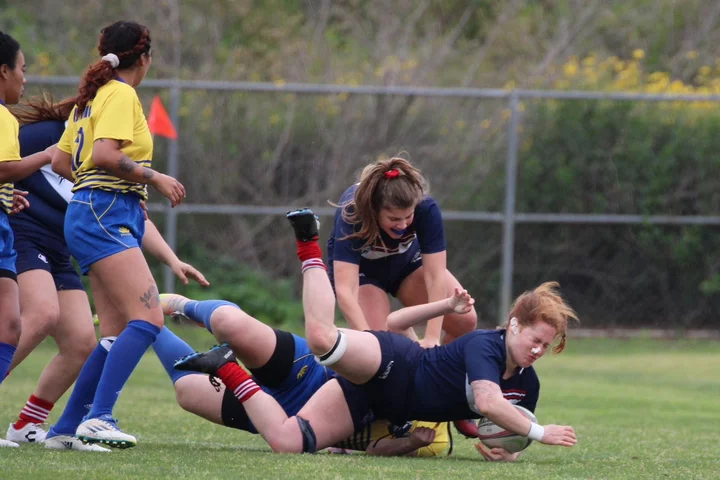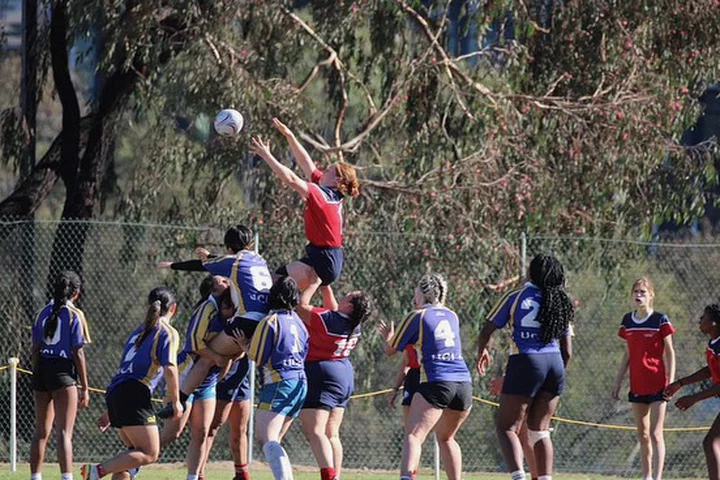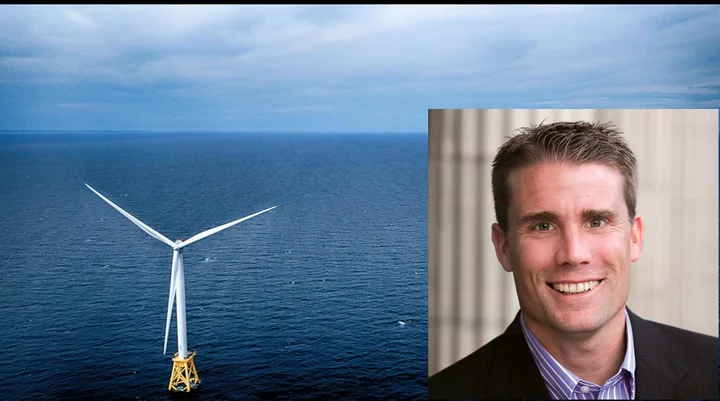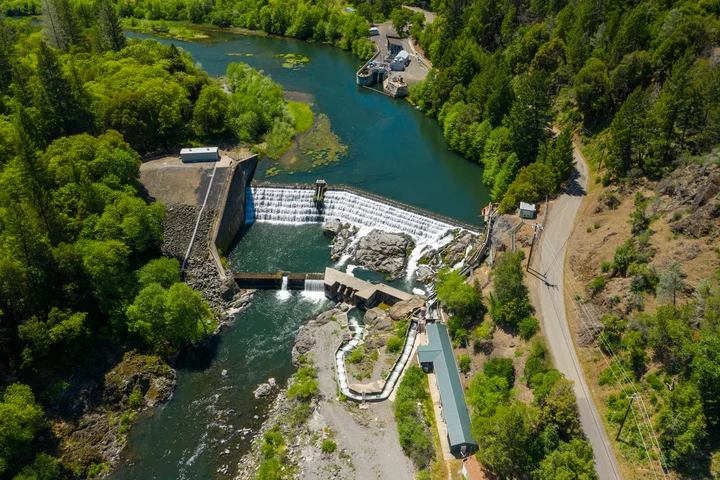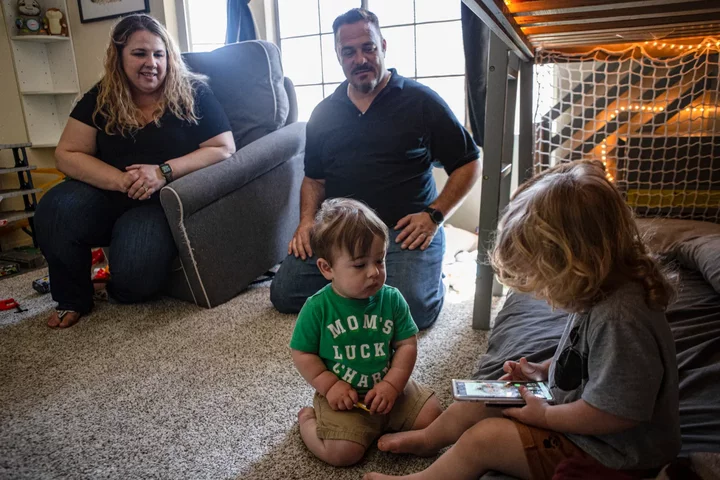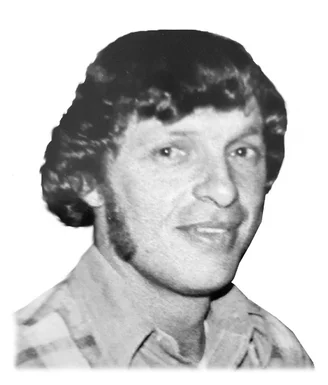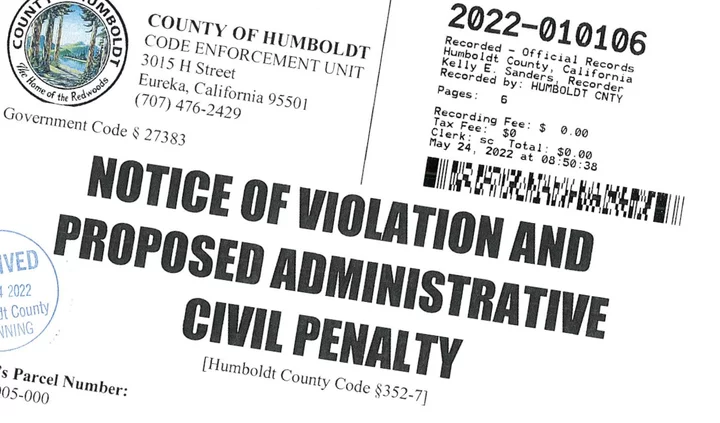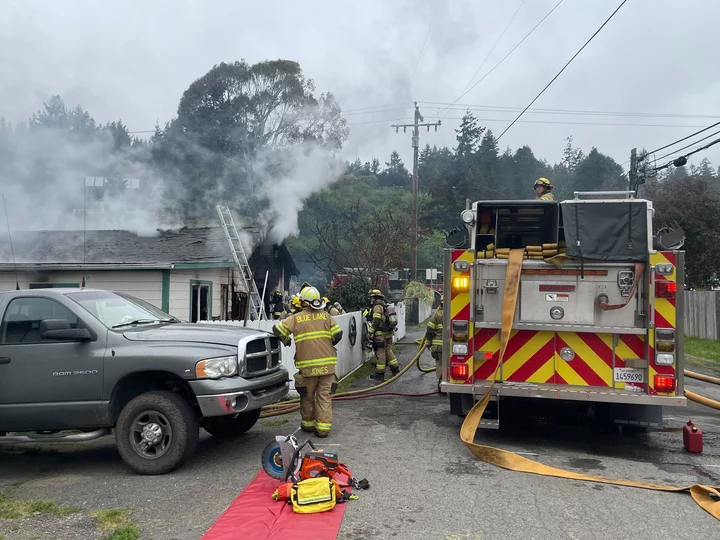OUT of the SCRUM! Meet the 18-Year-Old Arcata Native Whose College Rugby Team Just Won Nationals
Stephanie McGeary / Tuesday, May 16, 2023 @ 3:02 p.m. / Local Celebs , LoCO Sports!
Warner (in the foreground) on the rugby field earlier this year | Photos submitted by Evan Wollen
###
You probably saw all the hoopla earlier this year about Cal Poly Humboldt’s rugby team kicking butt at nationals. Well, in other rugby news, last weekend the Claremont Colleges women’s rugby team – the Foxes – won the College Rugby Association of America’s D2 National Championship for the second time. And though that might not usually be news of particular interest in Humboldt County, it turns out that one member of the national champion team is born-and-raised Arcata gal, 18-year-old Flannery Warner.
Warner, who graduated from Arcata High, just finished up her freshman year at Scripps College – one of five Claremont Colleges that have members on the team. So this was her first year playing rugby for the Foxes, which made it especially exciting for her to be part of winning nationals. In fact, Warner told the Outpost, it was actually her first year playing rugby at all.
“At Arcata High I was a competitive swimmer,” Warner said in a recent phone interview. “And then I decided when I went to college that I was kind of burnt out with swimming and I wanted to try something new. I knew that this team had won nationals the previous year. And so that of course was like a little bit intimidating, but I was like, ‘why not?’”
One of the nice things about the rugby team, Warner explained, is that anyone can join, even if they don’t have rugby experience. Since rugby is not a hugely popular sport in America, compared to American football or other sports, a lot of high schools do not have a rugby team. So many of the players are athletes coming from another sport, like soccer or basketball, and they learn how to play from the coaches and senior team members.
After new players join the team, the process is sort of “self-selecting,” Warner said, because many people realize within the first few days of training that rugby isn’t really for them. “A lot of people don’t continue because they realize they don’t like being tackled and all of that stuff,” Warner said.
But Warner said that even though she was a little wary of the intense physical contact of the sport at first, she discovered that she really likes it. As a swimmer Warner did a lot of weight training, which she said was something she always really enjoyed. One of the things that made her interested in transitioning to rugby is that it’s a sport that really emphasizes being physically strong.
The Foxes forwards after the national championship
OK, so here is the part where this reporter who knows nothing about rugby (or, really, sports in general) tries to explain a little bit about how rugby is played. If you are a rugby aficionado, just go ahead and scroll past this part and save me the embarrassment. During a rugby match, there are 15 players per team on the field, who are grouped into eight “forwards” and seven “backs.” One of the jobs of the forwards is to form the scrum, which involves the forwards from each team packing closely together with their heads down and attempting to gain possession of the ball. Warner generally plays as one of the “props,” whose role is to support the “jumper” as they compete for the ball.
Evan Wollen, one of the team’s coaches, told the Outpost that props have to be very strong and usually have a larger body type, so it is not a position commonly given to a freshman. But Wollen said that Warner is very strong and has worked very hard to prove her capabilities.
“Her statistics in the weightroom really improved over the year,” Wollen said in a recent interview. “She didn’t just show up and get that position. She worked her way into it.”
Of course, Wollen is very excited that the team won nationals for the second year in a row and is impressed with all of the team members, many of whom had never played rugby before joining the team. There are 40 members on the team and 25 on the roster for each game. In the nationals match against Howard University, Warner was put in as an alternate for the last 18 minutes of the game, Wollen said, and got to be a part of winning the title. As a particularly determined team member, Warner was always trying to figure out a way to be on the field.
“Her dedication was kind of an example for the other freshmen,” Wollen said. “She asks me at the end of pretty much every practice what she can do to improve. Trying to stay ahead of a player like Flannery is a challenge. But a good challenge.”
Warner being lifted in the line out against UCLA
Growing up in the hippie-town capital, Arcata, Warner’s drive seems to come from living in a very sports-centric family. Warner’s older and younger brother both also play team sports, and her father, Tim Warner, is one of the regular announcers for the Humboldt Crabs. The whole Warner family has spent many summers working at the Crabs games, and Flannery said she will be working with them again while she is home for the summer.
Other than working at the ballpark, Warner said that she plans to spend most of her summer back in Humboldt catching up on rest. In addition to playing rugby, Warner also has a full schoolwork load and is planning on majoring in biology and doing pre-med. With the team’s final game on the weekend right before finals, Warner and her teammates were stretched pretty thin, using most of their downtime in Houston to study in their hotel rooms. The team really didn’t even have enough time to celebrate their win.
But Warner said that traveling with her teammates was still a lot of fun and she is so excited to have been a part of winning the D2 nationals. Though she plans on going into the medical field after school, Warner said she plans to play rugby throughout her college career.
“It was super fun…” Warner said. “I think I would have been a lot more socially isolated without the team. I think that if I hadn’t had the team and the friendship of the team, [freshman year] would have been a very different experience.”
BOOKED
Today: 8 felonies, 9 misdemeanors, 0 infractions
JUDGED
Humboldt County Superior Court Calendar: Today
CHP REPORTS
2555 Harris St (HM office): Trfc Collision-No Inj
ELSEWHERE
County of Humboldt Meetings: CAT (Committee for Active Transportation) Meeting Agenda
KINS’s Talk Shop: Talkshop January 20th, 2026 – Frank Nelson
Governor’s Office: At World Economic Forum, Governor Newsom announces California shattered clean car goal, surpassing 2.5M ZEV sales despite Trump’s chaos
Washington Post: ‘I’ve never seen anything like it’: A winter drought grips the U.S.
State Senate Will Host Hearing on Offshore Wind and the Fishing Industry Tomorrow, McGuire’s Office Announces
LoCO Staff / Tuesday, May 16, 2023 @ 12:47 p.m. / Offshore Wind , Sacramento
Background: Block Island offshore wind farm. By Ionna22 - Own work, CC BY-SA 4.0, via Wikimedia.
Press
release from the office of Sen. Mike McGuire:
Senate Majority Leader Mike McGuire, Chair of the Joint Committee on Fisheries and Aquaculture (JCFA), is gearing up for this Wednesday’s hearing in the State Capitol focused on California’s burgeoning offshore wind industry. This hearing will explore how to expedite the deployment of green energy while protecting the interests of California’s fishing fleet and ensuring coastal environmental safeguards remain in place.
For the first time, the hearing will bring all sides of the issue together for a groundbreaking discussion that will feature representatives from federal and state agencies, tribal leaders, offshore wind industry representatives, representatives from the fishing fleet, labor leaders and environmental organizations.
Presenters will focus on why offshore wind energy is essential to the State’s green energy future and energy supply, the need to incorporate fish and wildlife in the development process, and how wind energy can be compatible with the protection of California’s fisheries.
“This first-of-its-kind hearing will bring all sides of the offshore wind discussion together, ensuring the State can expedite the deployment of this valuable energy resource while protecting the interests of California’s storied fishing fleet and guaranteeing coastal environmental safeguards,” said Senator McGuire. “It’s critical to have these voices at the same table as we develop the roadmap for offshore energy, healthy oceans and a thriving fishing fleet to co-exist here in the Golden State.”
The hearing begins at 2 p.m. tomorrow, Wednesday, May 17th in the State Capitol Swing Space, 1021 O Street, Room 2100. The public is welcome to attend the hearing.
The hearing will be live-streamed via the Senate Website. For more information about the hearing, visit the Committee web site at Committee web site.
Fishing and Conservation Groups Sue PG&E Alleging Harm to Salmon and Steelhead on the Eel River
LoCO Staff / Tuesday, May 16, 2023 @ noon / Courts , Environment
UPDATE, 3:12 p.m.:
After receiving a copy of the lawsuit, PG&E issued the following statement by spokesperson Paul Moreno:
We have just received the complaint and [are] reviewing it. We are confident that our Potter Valley Project’s operations are in compliance with all environmental laws, including the Endangered Species Act.
For the past 100 years of PG&E owning and operating the Potter Valley Project, PG&E has complied with the licenses issued by the Federal Energy Regulatory Commission (FERC) authorizing operation of the Project. The terms of PG&E’s current license, which remain in effect until the Project is licensed or surrendered by FERC, include requirements to comply with all environmental laws, including the ESA.
###
Original post:
Cape Horn Dam. | Kyle Schwartz, Caltrout.
Joint press release from California Trout, Friends of the Eel River, Institute for Fisheries Resources, Trout Unlimited and Pacific Coast Federation of Fishermen’s Associations:
San Francisco — A coalition of five commercial fishing and conservation groups have filed suit in federal court charging that Pacific Gas and Electric Company’s Potter Valley Hydroelectric Project on the Eel River is illegally harming salmon and steelhead listed under the federal Endangered Species Act.
Specifically, the lawsuit charges PG&E with maintaining and operating the Potter Valley Project in a manner that harms and harasses Coastal California Chinook salmon and Northern California steelhead trout, amounting to illegal “take” of these species. Legal representation for the groups is being provided by Earthjustice and Shute, Mihaly & Weinberger LLC.
The Potter Valley Project includes two dams, Scott Dam and Cape Horn Dam, which impede fish passage and block access to hundreds of miles of critical, high quality spawning and nursery habitat for Chinook salmon, steelhead trout, and pacific lamprey. PG&E is in the early phases of planning to decommission the facilities, which the company no longer wants due to the high costs associated with operating the aging structures. The hydroelectric portion of the Project no longer produces electricity after a transformer failure in July of 2021.
“These obsolete dams are harming fish populations in several ways,” said Matt Clifford, California Director of Law and Policy for Trout Unlimited. “In addition to blocking the migration of both adult and juvenile salmon, the operation of the Project results in stream temperatures that are too hot for these populations to recover. We’re asking the court to ensure PG&E operates the facilities in a way that will preserve fish populations so that they will be able to take advantage of dam removal when it occurs.”
The National Marine Fisheries Service (NMFS) has made it clear to PG&E and federal dam regulators that keeping ESA-listed Chinook and steelhead populations off extinction’s edge in the near future will require immediate changes to PG&E’s operations of the Potter Valley Project. In March 2022, NMFS wrote that the Potter Valley Project “is causing take of ESA-listed salmonids in a manner not anticipated in the (2002 Biological) Opinion and from activities not described in the Opinion.” This May 11, NMFS noted that the “Cape Horn Dam Fish Passage Facility currently does not have ESA take coverage and is likely non-compliant with NMFS fish passage guidelines.”
“Both Scott and Cape Horn dams are clearly causing take of Eel River salmon and steelhead. To the extent they ever had a permit to cause those harms, PG&E no longer enjoys those legal protections,” said Clifford.
The lawsuit makes several specific claims against the utility for operating the facilities in a manner that harms native fish. These claims include maintaining water temperatures below the dams that are too high for salmon and steelhead; operating Cape Horn Dam and its fish passages facilities in a manner that directly causes injury and death to species listed under the Endangered Species Act; blocking access to high-quality habitat above the dams; and making it difficult for juvenile fish to migrate out to sea.
“We expect PG&E to propose the removal of both Eel River dams in this fall’s decommissioning plan. Scott Dam faces serious seismic safety concerns and has no fish passage,” said Alicia Hamann, Executive Director for Friends of the Eel River. “But Cape Horn dam is also very problematic for fish and the ecological function of the river. The fishway at the dam harms and harasses fish whose populations are already severely depressed. Fish ladders are really difficult to operate in a sediment-rich river like the Eel and PG&E has been operating this ladder for years despite known risk to these protected species. The best move for PG&E and the Eel River is to remove both dams as soon as possible.”
PG&E revealed in March of this year that the larger of the two dams, Scott Dam, is at higher risk of failure in an earthquake than was previously understood. Due to the increased danger, state dam regulators will no longer allow the Lake Pillsbury reservoir to be fully filled. PG&E is scheduled to file a draft decommissioning plan with the Federal Energy Regulatory Commission (FERC) in November of 2023. The plan will spell out the specifics of how the utility plans to wind down Project operations for good and how it plans to deal with the facilities.
“The real solution here is to completely remove these obsolete dams from the river,” said Redgie Collins, Legal and Policy Director for California Trout. “We applaud PG&E for seeking to decommission this Project, but in the interim, they need to operate the Project in a way that reduces its impact on fish and is compliant with the law. We understand that the dams could be out in five years or perhaps even less, but PG&E needs to comply with the law starting today.”
“Salmon season is closed this year for the second time,” said Vivian Helliwell, Watershed Conservation Director for the Pacific Coast Federation of Fishermen’s Associations. “West Coast salmon and steelhead populations are really struggling right now, and along with them our coastal and inland communities that rely on these fish for food and jobs.”
The Eel River was once one of the most productive salmon rivers in California with returns of commercially important Chinook salmon estimated to be as high as 800,000 fish in good years. “The poor operation of the Potter Valley Project by PG&E is directly impacting the fish these communities rely on,” added Helliwell. “For our coastal fishing families, fixing these issues can’t come soon enough. We need these populations to be healthy enough to support a harvestable surplus above the minimum numbers needed for delisting. The Eel River has the potential to support that kind of recovery.”
‘I’m a Hostage’: Why California’s COVID Unemployment Mess Isn’t Over Yet
Lauren Hepler / Tuesday, May 16, 2023 @ 7:05 a.m. / Sacramento
Sharon and Nicolas Allen watch their two sons play in their home in Fresno on April 10, 2023. Photo by Larry Valenzuela, CalMatters/CatchLight Local
It’s been 22 months and three unemployment appeals since Nicolas Allen’s last job in Fresno.
In the time it has taken the 44-year-old graphic designer to win a fraction of the benefits that he applied for, his wife has weathered a high-risk pregnancy, his youngest son was born and his family has been pushed to the financial brink.
Now, Allen is one of thousands of Californians who say they lost jobs due to the pandemic, but are still fighting lengthy legal battles over unemployment money that state and federal relief programs were designed to provide. It’s a ripple effect of earlier benefit backlogs that ensnared some 5 million people at the state Employment Development Department (EDD), which officials have said was unprepared and overwhelmed by mass job losses.
Those caught up in payment disputes say they have struggled with debt, housing and necessities like food or health care. Meanwhile, no one is publicly tracking how much appeals cases and lawsuits might end up costing workers or taxpayers in a state that still owes the federal government nearly $19 billion in unemployment debt.
“It’s easier to not think the money’s there,” Allen said. “Because if I worry about it too much, it’s too painful.”
The EDD has paid out $188 billion in unemployment benefits since the first pandemic shutdowns. State and federal officials waived many ordinary application requirements as millions of claims flooded in, and the agency has acknowledged that up to $31 billion was paid to scammers in the rush to distribute money quickly.
Along the way, state watchdogs say up to 1 million workers were wrongly denied benefits — many mistakenly flagged for committing fraud themselves. “Accusing people of fraud is a big deal,” said George Warner, director of the Wage Protection Program at San Francisco’s Legal Aid at Work. “And the EDD does it very casually, very frequently.”
The biggest logjam of contested unemployment cases lies in a state appeals process, where more than 1 million workers have asked for a review of EDD’s decisions in their cases since March 2020. About 880,000 of those cases have already been transferred and heard by a lesser-known state labor agency, the California Unemployment Insurance Appeals Board, where the average case is still languishing for 139 days before a hearing with a judge, federal data shows.
Dozens of workers who have exhausted this state process have elevated their claims even further, to appellate or superior courts. Finally, advocacy groups and hundreds more workers have joined proposed class-action lawsuits against the EDD or its debit card contractor, Bank of America.
Both the EDD and the Appeals Board refused requests for interviews to discuss workers’ concerns and state efforts to respond. The agencies also referred some inquiries to one another or offered conflicting answers, raising questions about how delays and associated costs are being tracked.
“I had no money, and I kept saying: ‘How long is this going to take?’”
Carole M., office manager in Southern California
Gregory Crettol, assistant director of the California Unemployment Insurance Appeals Board, told CalMatters in a statement that the Appeals Board has hired and trained 105 judges and 100 new support staffers since the onset of the pandemic. The board is also rolling out a new online system for workers to track their cases, and officials said at an April meeting that judges are now closing almost twice as many cases per month as pre-pandemic.
Still, “Given the historic backlog of appeals,” Crettol said in a statement, the Appeals Board “anticipates it will likely take several more years to completely resolve before workload returns to normal levels.”
Unemployment cases are complex and vary widely, but workers awaiting disputed funds have faced similarly dire challenges. A 33-year-old video editor in Burbank had to create a GoFundMe to restart her life during a gender transition. A security guard In L.A. County worried whether fellow workers still seeking unemployment would end up in the homeless camps he once patrolled. A 62-year-old temp worker in Sacramento spent months terrified she’d lose her car, and a legal office manager in Southern California filed for food stamps and MediCal to survive an appeal with no end in sight.
“I really feel like I’m a hostage,” said the office manager, who asked to be identified only as Carole M. and has been awaiting an appeal hearing since November. “I had no money, and I kept saying: ‘How long is this going to take?’”
Fraud fury
Like many of California’s COVID-era unemployment challenges, slow and unwieldy payment disputes aren’t new. But the pandemic did two things: unleash an unprecedented flood of 29 million jobless claims, and supercharge anxiety about a new generation of online fraud.
Rival politicians have seized on jobless claims filed in the name of death row inmates and YouTube rappers bragging about EDD-fueled spending sprees. Investigators attribute the bulk of pandemic unemployment fraud to organized identity theft. Unemployment attorneys, meanwhile, say they’re seeing regular workers who thought they were eligible for benefits disqualified — and sometimes charged with lying — in cases that can sometimes be explained by confusion about state forms, clerical errors, language barriers or disagreements between workers and employers.
“It’s so wrong,” said Assaf Lichtash, founding attorney of Los Angeles-based Pershing Square Law Firm. “The way I see it, the EDD is punishing regular civilians that are just filing for benefits who make honest mistakes — they’re punishing them for their failure to safeguard the money from fraudsters.”
State reports have also highlighted a disconnect between the EDD’s ham-fisted approach to large-scale fraud and what some say seems like a hair-trigger impulse to flag individual workers. Organized scammers evaded the agency’s automated application systems early in the pandemic, one September 2020 report by a governor-appointed EDD Strike Team found, while the vast majority of individual workers scrutinized in manual reviews appeared to be innocent.
“Processes intended to block fraud are slowing service delivery without catching fraud,” the Strike Team wrote, since just .02% of the 1.3 million cases flagged that summer appeared to be real fraud. “The cost of finding that small number of imposters is extremely high.”
A separate report last August by the Legislative Analyst’s Office found that, during the pandemic, state appeals judges overturned EDD unemployment denials up to 80% of the time. That report highlighted another sample of 1.1 million unemployment claims stopped due to fraud concerns by an EDD consultant early in the pandemic, where at least 600,000 cases were later “confirmed as legitimate” and workers saw payments needlessly delayed. Even before COVID upended the job market, the Analyst’s Office estimated that improper unemployment denials cost workers $500 million to $1 billion a year in unpaid benefits. The agency also noted “concerning steps” at EDD in recent years that “suggest that ensuring eligible workers get benefits is not among its top priorities.”
The EDD refused to discuss its approach to appeals during the pandemic. Over the past three years, the agency has invested heavily in new anti-fraud technology and sought federal waivers for some workers who may have received extra federal pandemic unemployment funds “through no fault of their own.”
For workers who still want to fight an unemployment case, the first step is to notify the EDD in writing. The EDD then transfers the case to a local office of the Appeals Board, which schedules a hearing with an administrative judge. If a worker or business still feels that their case is unresolved, they can file another appeal with the state-level office of the Appeals Board, or eventually escalate the case to a superior or appellate court.
As of March, the average first-level appeals case with a judge was taking 139 days — a lag not as extreme as some other states, U.S. Department of Labor data shows, but still roughly triple the federal government’s 30- and 45-day targets for state unemployment appeals.
This kind of surge is predictable after a recession; the Appeals Board heard about 1.6 million cases in the years around the Great Recession, Crettol said. But workers like Allen, the Fresno graphic designer, have seen first-hand how pandemic cases can be complicated by heightened focus on fraud and differing interpretations of emergency health orders.
In Allen’s case, he told state officials that he quit his job in July 2021, when the Delta variant of the coronavirus was raging and his wife was instructed not to be vaccinated against COVID-19 while navigating a high-risk pregnancy. Since health precautions like masking were not strictly enforced at his in-person job as a sign installer, Allen wrote in a state appeals filing, he quit “to eliminate the risk of bringing COVID-19 home.”
One unemployment payment arrived, but then the money stopped.

Nicolas Allen in his home in Fresno on April 10, 2023. Photo by Larry Valenzuela, CalMatters/CatchLight Local
“I was told that it had been reported that it was a fraudulent claim,” Allen said. “Because my former employer was claiming that I quit without cause.”
So began an odyssey that involved months of arguing about pandemic protocols, clerical confusion over a brief freelance gig and paperwork ping-ponging between the EDD and the Appeals Board. After the second appeal, a state judge awarded Allen about six weeks out of the six months of benefits he applied for — securing around $3,000 of the $10,000 he sought, not counting potential federal unemployment supplements available during the pandemic — but denied the rest after questioning how actively he was seeking work while caring for two children under age 2.
Across the state, some 170,000 other appeals cases are still pending, according to the most recent data reported by the U.S. Department of Labor. Crettol said the Appeals Board is encouraged that new appeals have started to decline in recent months, and cited a lower state count of 154,000 backlogged cases through the end of March — a discrepancy that he said stems from differences in how state and federal numbers are reported due to funding sources and EDD processing times.
Attorneys like Lichtash add that for those stuck waiting, one challenge is a lack of information about if and when a case has been transferred to the Appeals Board from the EDD, the latter of which he called a “black hole.”
The EDD said in a statement to CalMatters that it sends cases to the Appeals Board in an average of three days. The Appeals Board offered a conflicting number: that it receives about two-thirds of appeals within a week after an appeal is filed, which Crettol said could differ due to how the two agencies track processing times. Neither agency regularly tracks the “monetary value” of appeals cases, or how much the state is being awarded or ordered to pay, spokespeople said.
For workers like Allen caught in the fray, the price of being caught up in the confusion has been high.
His family slashed expenses like cable TV and was able to refinance their house, which they credit with avoiding falling behind on the mortgage. But Allen said they were still forced to borrow money from family and take on credit card debt, putting everyday luxuries like a dinner at a restaurant with their kids out of reach.
“It’s horrible. I mean, we’re living off my paycheck,” said Allen’s wife, Sharon, who works in human resources. “We’ve almost divorced a few times because of it.”
A path for reform?
In many ways, unemployment advocates like Jenna Gerry say the pandemic has shone “a spotlight” on chronic problems with the state’s job safety net, from worker confusion over benefit denials to delays at EDD to inconsistent anti-fraud efforts.
The question she and others are asking now is whether state officials will act to change the system that has once again gone haywire, or whether workers caught up in pandemic disputes will be left to bear the brunt of the confusion.
“It was a perfect storm,” said Gerry, a senior staff attorney with the National Employment Law Project. “Instead of being like, ‘Wow, that was really bad. How do we make reforms now?’ … all people want to lift up is fraud, and not actually look at the systemic issues.”
The biggest underlying issue, Gerry said, is that millions of California workers — such as gig workers, undocumented workers and others in tenuous hourly positions — aren’t eligible for normal unemployment benefits. That was why the federal government started emergency jobless programs like Pandemic Unemployment Assistance. But subsequent high rates of fraud in the emergency program have complicated conversations at the federal and state levels about whether to make elements of the program permanent to cover more workers.
“All people want to lift up is fraud, and not actually look at the systemic issues.”
— Jenna Gerry, staff attorney with the National Employment Law Project
One potential change that advocates are watching closely in California is a plan to finally upgrade the state’s unemployment technology. The Appeals Board says it is rolling out a new system now, and the EDD is preparing to launch an effort called EDDNext. The challenge will be ensuring that such projects are more effective than other costly upgrades after the Great Recession, which audits said buckled at the EDD during the pandemic.
Among the more targeted reforms that state agencies have recommended, but which legislators have yet to act on: removing the EDD from the appeals process, expanding the role of the Appeals Board or adding a new surcharge for businesses that frivolously appeal unemployment insurance (UI) claims.
“To correct state practices that have the effect of limiting UI payments,” the Legislative Analyst’s Office wrote last summer, “the state should give the appeals board the authority and responsibility to set UI policy and practices.”
As these debates drag on, some unemployment advocates and workers are taking matters into their own hands.
In one Alameda County lawsuit against the EDD, the Sacramento-based Center for Workers’ Rights negotiated a February settlement to head off more payment disputes. The EDD agreed to cancel around 5,000 notices of overpayment sent to workers already past a year-long statute of limitations, and to refrain from sending other similar notices past the allowed timeframe.
The agreement applies only to workers not flagged for potential fraud, leaving attorneys to worry that others still caught up in disputes or unsure how to contest their cases will slip through the cracks. Workers marked for making false statements to EDD face severe penalties — they could be forced to repay the money at high interest, have their wages garnished or be disqualified from collecting benefits if they lose a future job.
“The burden is generally put on the claimant to appeal,” said Daniela Urban, executive director of the Center for Workers’ Rights. “But these notices never should have been issued.”

Madeline Maye, a video editor based in Burbank on Feb. 12, 2023. Maye lost $5000 to the Bank of America EDD debit card fraud of 2020. She had been laid off from her job just months earlier and was struggling to find freelance video editing work in the pandemic. The situation was compounded for Maye by the fact that she had just come out as transgender, was navigating hormone therapy, and trying to pay for essentials like rent and feminine-presenting clothes and products. Photo by Alisha Jucevic for CalMatters
Farther south, in Burbank, Madeline Maye is still seeking some form of closure two years into another proposed class action lawsuit.
The timing couldn’t have been worse in mid-2020, when, in the midst of hormone therapy and a gender transition, the video editor became one of thousands of California workers who noticed money draining from their unemployment debit cards in alleged fraudulent charges. The next year, she joined a class action claim against the state’s debit card contractor, Bank of America, which is now awaiting a hearing date before a federal judge in San Diego.
Bank of America has filed to dismiss the suit and declined to comment on ongoing litigation. It was separately fined $225 million last year by federal regulators for what they deemed “botched disbursement of state unemployment benefits.”
In Maye’s case, it took about six months to get her unemployment money back from the bank, forcing her to start a GoFundMe account to pay rent and buy essentials like new clothes to restart her life. Her lawsuit is one of several that will test what justice might look like after the state’s job safety net failed.
“I got my money back, but it was one of the worst times in my life,” Maye said. “It felt like I was alone — that no one gave a shit about me.”
###
CalMatters.org is a nonprofit, nonpartisan media venture explaining California policies and politics.
OBITUARY: David G. (‘Crackers’) Lenardo, 1950-2023
LoCO Staff / Tuesday, May 16, 2023 @ 6:56 a.m. / Obits
Dave “Crackers” Lenardo passed away peacefully surrounded by his loved ones.
He was born to John Junior and Dorothy Lenardo at the Scotia Hospital on March 27, 1950.
He grew up on the family dairy ranch in Port Kenyon, Ferndale, learning both the language and customs of his Portuguese and Danish heritage.
Dave’s education began at Port Kenyon School, then transferred to Ferndale Elementary and High Schools.
Throughout the Eel River Valley, Dave was known as an early riser, fed and milked lots of cows, moved irrigation pipes, cut, raked, baled and hauled hay and tilled the soil.
He also built buildings and miles of fences.
Tractor work was his favorite. Lots of hours were spent mowing grass and weed eating fence lines.
Agriculture was his passion with his strong work ethic and sense of humor.
Country music was always playing, even in the cow barn.
Dave spent most of his time on earth being a good steward to the farmland and animals.
He always enjoyed nature and the outdoors, especially Centerville Beach when the surf fish were running.
Dave is in the presence of his Heavenly Father, experiencing never-ending love joy and peace.
Dave is survived by his siblings: John Lenardo, III, Joan (Tom) Hubner, and Patsy (John) Miranda; and his children: Jereme (and Amber), Heather, Kevin, Shawna, Bernadette, Bradley (and Trisha); and grandchildren: Shaylynn, Kelsey, Hunter, Bradley Jr., Casey, and Charlotte; and his partner Mary Enos-Lenardo.
He is also survived by many wonderful nieces, nephews, cousins and friends.
Dave was preceded in death by his parents John G. Lenardo Jr. and Dorothy (Hansen) Lenardo and his sister Rita Lenardo.
The family will be holding a private celebration of life.
###
The obituary above was submitted on behalf of Dave Lenardo’s loved ones. The Lost Coast Outpost runs obituaries of Humboldt County residents at no charge. See guidelines here. Email news@lostcoastoutpost.com.
Federal Judge Tosses Class Action Suit Challenging Humboldt County’s Cannabis Code Enforcement Processes
Ryan Burns / Monday, May 15, 2023 @ 5:26 p.m. / Courts
Detail of a county notice of violation.
###
United State Magistrate Judge Robert M. Illman on Friday dismissed a federal class action lawsuit brought by the nonprofit Institute for Justice on behalf of a group of Southern Humboldt property owners who alleged that the county’s cannabis code enforcement practices were illegal.
Specifically, the claim argued that the county’s administrative processes to abate illegal weed grows violated the plaintiffs’ constitutional right to due process; levied exorbitant and unjustified fines and fees; and deprived plaintiffs of their alleged constitutional right to have a jury present at an administrative hearing.
The lawsuit, which was filed last year, named the County of Humboldt as a defendant along with all five county supervisors by name and county Planning Director John Ford, in their professional capacities.
Having read Judge Illman’s 52-page decision (a link to which you can find below), I think it’s fair to say he effectively laughed this case out of court. His ruling repeatedly and comprehensively rebukes the arguments put forward by plaintiffs’ attorneys, describing their reasoning variously as “implausible,” “baseless,” “unreasonable,” “ineffectual” and riddled with “gross mischaracterizations.”
Here’s just one example of his upbraiding:
Despite the [first amended complaint’s] length, overlooking its irrelevant content, and its conclusory and implausible assertions – and in light of the materials of which the court is taking judicial notice – it becomes clear … that the underlying facts do not, and simply can not, entitle these Plaintiffs to any relief against these Defendants.
Here’s another:
Spanning 70 pages, with more than 600 numbered paragraphs, the [complaint] is overwhelmingly dominated by legal arguments couched as factual allegations, unreasonable inferences, unwarranted deductions, conclusory assertions, unjustified labels, and hyperbole. As to the relatively small number of paragraphs that do contain actual allegations of fact, the vast majority of that content is either irrelevant or simply implausible.
He takes the plaintiffs’ allegations one by one. Regarding a claim that they had been subjected to “excessive fines and fees,” Judge Illman proceeds to describe each one’s individual circumstances before noting, “No party has actually paid a fine.”
Regarding a claim that the county routinely denies land-use permits to landowners with outstanding abatement orders, Judge Illman writes, “Plaintiffs concede that they have not actually received any such final decisions by having had any such land-use permit applications rejected.”
Regarding the demand for a jury trial he writes, “[T]here is no right to a jury trial in the sort of administrative hearing at issue here – something which Plaintiffs appear to vaguely concede.”
Furthermore, he observes, the county’s code enforcement regulatory framework “expressly provides for full-fledged judicial review after the conclusion of the administrative phase of the proceedings.”
The allegation that the plaintiffs have been denied due process, meanwhile, gets dismissed for failure to state a claim. Attorneys for the plaintiffs listed ten examples of the county’s alleged failure to provide adequate notice or an opportunity to be heard, but Judge Illman concludes, “all either implausible, irrelevant, conclusory, or are based on unreasonable inferences or unwarranted deductions.”
Ultimately he dismissed every last claim with prejudice, meaning the suit cannot simply be refiled in U.S. District Court’s Northern District of California, where it was heard.
But in a press release published on Redheaded Blackbelt, attorneys with the Institute for Justice vow to appeal the decision to the Ninth U.S. Circuit Court of Appeals.
The press release says the judge “accepted as true many of the county’s factually incorrect statements,” and attorney Jared McClain adds, “We disagree with the court’s decision and will continue to fight for justice on appeal, ensuring that the rights of Humboldt County property owners are protected.”
In an emailed statement, Humboldt County Public Information Specialist Cati Gallardo said, “While we were disappointed that a small number of residents chose this route in an attempt to resolve their existing violations, we are pleased by the court’s decision. The United States Magistrate Judge is direct in the rationale for ruling on each count, and we appreciate the clarity provided by the court. We look forward to resuming collaboration with property owners to resolve these and other open cannabis-related cases.”
###
Blue Lake Fire Says One Dog, Two Cats Missing in Today’s House Fire
LoCO Staff / Monday, May 15, 2023 @ 1:53 p.m. / Fire
Photo: Ryan Burns.
###
PREVIOUSLY:
###
Press release from Blue Lake Fire:
On May 15, 2023 at approximately 9:12am Blue Lake Fire Department was dispatched to a reported residential structure fire at the 500 block of Hartman Street. Initial reports stated there was a possible explosion at the residence. One Blue Lake Engine responded as well as the Blue Lake Chief. Upon arrival crews found a single story residential structure fully involved.
Firefighting operations established a defensive attack. It was determined that the “explosions” heard from the residence was the result of a large amount of ammunition present as scene. The Humboldt County Sherriff’s Office issued an evacuation order for the residents in the immediate area of Hartman and Blue Lake Boulevard. Fire personnel had the fire knocked down in approximately 35 minutes after the initial dispatch.
One dog was rescued from the structure, however, one dog and two cats were not accounted for at scene after firefighters looked through the home after the fire was controlled. Blue Lake’s Chief began to release mutual aid resources at approximately 11:00am; crews remained on scene for clean up until 12:30pm. The cause of the fire is still under investigation; at this time it is unclear as to what started the fire.
Blue Lake Fire would like to thank our allied partners for their assistance during this incident, Fieldbrook Fire, Arcata Fire, Humboldt Bay Fire, and Westhaven Fire. We would also like to thank CHP, PG&E and HCSO.

